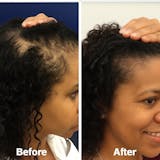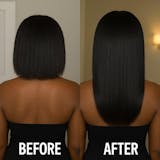Postpartum Hair Loss: Causes, Timeline, and Natural Solutions

If you’ve noticed your hair shedding more than usual after having a baby, you’re not alone. Postpartum hair loss—also known as telogen effluvium after pregnancy—is extremely common and affects most women in the first year after giving birth.
The good news? It’s temporary, and with the right natural solutions, you can support regrowth, restore fullness, and strengthen your hair.
Why Does Postpartum Hair Loss Happen?
During pregnancy, high estrogen levels keep hair in its growth phase longer, which is why many women enjoy thicker, fuller hair while expecting. After childbirth, estrogen levels drop, causing a larger-than-normal number of hairs to enter the shedding phase.
When Does Postpartum Hair Loss Start—and Stop?
- Start: Usually begins 2–4 months postpartum
- Peak shedding: Between 4–6 months postpartum
- Stop: Noticeable improvement for most women by 9–12 months postpartum
Signs You’re Experiencing Postpartum Hair Loss
- Clumps of hair in your brush or shower drain
- Thinning edges or hairline recession
- Increased scalp visibility
- Bald spots (especially around temples or crown)

Natural Solutions to Regrow Hair After Pregnancy
While postpartum shedding can’t be stopped completely, nourishing your scalp, supporting follicles, and avoiding damage can speed recovery and promote thicker regrowth.
1. Power Oils for Postpartum Hair Regrowth
Using the best hair oils for postpartum hair loss can help nourish your scalp, stimulate dormant follicles, and improve hair thickness.
- Rosemary Oil – Boosts circulation and promotes follicle activity (proven as effective as minoxidil in studies)
- Peppermint Oil – Invigorates the scalp and relieves dryness or itchiness
- Castor Oil – Seals in moisture, strengthens strands, and reduces breakage
- Caffeine Extract – Helps block DHT, a hormone linked to hair thinning
- Argan & Jojoba Oils – Provide essential fatty acids and vitamins for scalp health

2. Gentle Scalp Massage
Incorporating a gentle scalp massage into your daily routine is one of the simplest yet most effective ways to encourage postpartum hair regrowth. Using your fingertips or a soft silicone scalp massager, apply light to medium pressure in small circular motions, working from the hairline toward the crown and down to the nape of your neck. This process boosts blood circulation to the scalp, ensuring that oxygen and nutrient-rich blood reaches your hair follicles—fueling growth at the root.
For best results, combine your massage with a nourishing oil like rosemary, peppermint, or caffeine-infused blends. The massage helps these oils penetrate deeper into the scalp, enhancing their follicle-stimulating effects. Aim for at least five minutes each day, preferably before bedtime or while washing your hair, to promote relaxation and maximize hair growth potential.

3. Nutrition for Hair Recovery
Postpartum recovery and hair health are closely linked. Include:
- Iron-rich foods: spinach, lentils, beef
- Protein sources: eggs, salmon, Greek yogurt
- Omega-3 fatty acids: walnuts, chia seeds, flaxseeds
- Biotin sources: almonds, sunflower seeds, sweet potatoes

4. Protective Styling & Minimal Heat
Choosing the right hairstyles during the postpartum period can make a significant difference in preventing further hair damage and encouraging regrowth. Hair that is already shedding or thinning—especially around the hairline—can be more fragile, making it prone to breakage if pulled too tightly or exposed to excessive heat.
Opt for protective styles that keep manipulation to a minimum, such as loose braids, twists, low buns, or silk/satin head wraps. These styles reduce tension on the hair shaft and scalp, allowing delicate new growth to emerge without stress. Always avoid styles that pull tightly on the edges, as repeated tension can lead to traction alopecia, a form of hair loss that can be difficult to reverse.
When it comes to heat styling, less is more. Limit the use of flat irons, curling wands, and blow dryers to special occasions, and always use a heat protectant spray when you do style with heat. For everyday maintenance, embrace air-drying and low-heat tools to preserve hair strength and elasticity.
Switching to silk or satin pillowcases and hair ties made from soft, snag-free materials can also help reduce friction and breakage while you sleep or style your hair. This gentle approach gives your hair the best chance to recover its natural thickness and shine after pregnancy.
5. Switch to a Gentle, Sulfate-Free Hair Routine
Postpartum hair is often more fragile, drier, and prone to breakage, making it essential to adopt a hair care routine that cleanses without stripping away natural oils. Traditional shampoos containing sulfates—like sodium lauryl sulfate (SLS) and sodium laureth sulfate (SLES)—can be too harsh for delicate postpartum hair, leaving it dry, brittle, and more likely to shed.
Switch to a sulfate-free shampoo that uses mild, plant-based cleansers. These formulas gently remove dirt, excess oil, and buildup without disrupting your scalp’s natural moisture balance. Look for added nourishing ingredients such as aloe vera, argan oil, jojoba oil, shea butter, or coconut-derived cleansers to hydrate and strengthen hair while soothing the scalp.
Follow up with a rich, silicone-free conditioner that replenishes moisture and smooths the hair cuticle. Silicone-free formulas prevent buildup that can weigh down fine, thinning hair, allowing it to look fuller and healthier.
Limit shampooing to 2–3 times per week to avoid over-drying, and incorporate a weekly deep-conditioning mask or hot oil treatment to repair and fortify weakened strands. When drying your hair, gently blot with a microfiber towel instead of rubbing with a cotton towel, which can cause friction and breakage.
By using gentle, sulfate-free products and focusing on hydration, you create a healthy scalp environment that supports stronger roots, reduces shedding, and promotes thicker postpartum regrowth.
How Long Until Hair Grows Back?
Most women notice regrowth within 6–9 months with proper care, and full recovery by 12 months postpartum. Consistency is key—results improve when natural remedies are used regularly.
Seddy Hair Growth Oil: Your Natural Postpartum Ally
If you want a ready-made, nutrient-rich blend for postpartum hair recovery, Seddy Hair Growth Oil combines:
- Caffeine – Helps block DHT and awaken follicles
- Rosemary & Peppermint Oils – Boost circulation and stimulate growth
- Castor, Argan, & Jojoba Oils – Hydrate, strengthen, and restore shine
Formulated to reduce shedding, nourish the scalp, and thicken edges, it’s safe for daily use on all hair types—perfect for postpartum moms ready to regrow their hair naturally.
💛 Reclaim your hair confidence after pregnancy—shop Seddy Hair Growth Oil today and see the difference in as little as 4 weeks.












